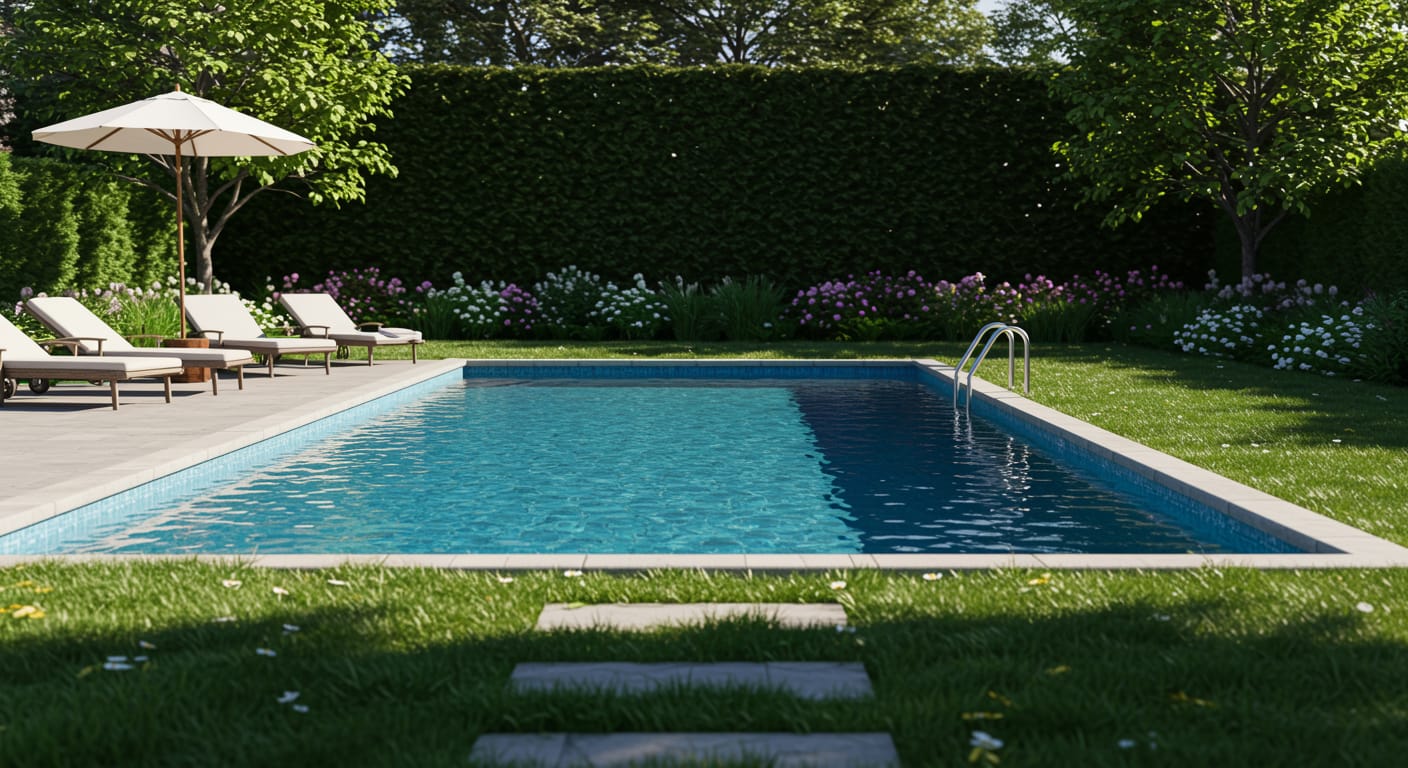Grass Around Pool: A Practical, Code-Savvy Guide

Pool owners, is this the best way to make your home look great? On Saturday, guests are arriving. In the morning, you mow the lawn, blow the clippings, and spend an hour mowing the grass before guests arrive. Is there a way to reduce labor and get a free weekend?
Yes, tips in this guide will help you. For better pool landscaping, consider incorporating grass around the pool. You can have a green edge beside coping, natural turf bands, paver-and-lawn grids, and grass-like groundcovers. They look luscious and feel soft on bare feet, yet don’t foul the water.
To achieve the best grass pool designs, consider incorporating a hardscape buffer to enhance the poolside edging and complement climate-fit grasses, thereby reducing pool lawn care and irrigation needs to minimize debris. Are you concerned about maintaining pool grass?
No need, because this guide is to help you with layout patterns to keep water clean, grass types, smart irrigation, maintenance, and practical tips for your poolside lawn care.
Plan the Layout: Keep Water Clean and Feet Safe
How do you keep your pool water clean? The grass around poolside edging will keep your water clean by absorbing rainwater and nutrients that end up in your pool. Every winning starts with a plan. Win for better pool landscaping, it begins with a hardscape buffer and green band, clean walking routes, and debris barriers. Remember, your safety and clarity are more important than aesthetics. Your grass won’t get ruined because there are salt-tolerant grasses listed, too, in this blog.
Create a Hardscape Safety Buffer
Do you want to control skimming time in your pool maintenance? Or you already have grass around the pull and want to reduce tracking or trimming time? Have a continuous nonslip path around the pool to reduce tracking, trimming, and skimming time by hindering weed growth.
As a homeowner, a hardscape path design of 3-4 feet is a practical choice.

Note: Public pools require wider paths. They should follow local rules.
Use Paver-and-Lawn Grids Where Traffic is Highest
If you are considering a modern paver-and-lawn grid layout, then have turf joins for drainage and clean the footing near ladders, benches, and outdoor showers. Joint width should be 1-2 inches. A better edging detail will halt encroachment and keep soil solid. This will prevent weeds from growing.
Add Mow Strips and Edging to Stop Clipping at the Source
You know how to reduce trimming time, but what about stopping weeds at the source? Won’t this save your time even further? To save your time, have steel, concrete, or composite (bold) edging between the deck and the lawn, which will curb rhizomes and stop weeds from growing at the source.
Pro tip: By placing a “buffer bed” like rock or dense groundcover, you will use downwind of prevailing breezes to trap debris before coping.
Choosing the Right Grass for Pools
As a pool owner, you get confused about natural grass versus artificial turf, and what to choose. Here is a comparison table to help you decide which is the best grass around the pool:
Natural Grass vs Artificial Turf
| Natural Grass | Artificial Grass | ||
| Pros | Cons | Pros | Cons |
| Cooler underfoot | Requires mowing and edging | No mowing | Too hot to touch if left in the Sun |
| Softer on skin | Clippings can reach the pool | Year-round green color | Abrasive on bare skin |
| Eco-friendly | Seasonal wear | Reduced water needs | Shades particles into the pool |
| Looks natural | Moderate maintenance | Less maintenance | Not environmentally friendly |
Now you understand why natural grass is better for pool landscaping, considering the safety, comfort, and it even keeps your feet cooler. But that doesn’t mean that artificial turf is not a salt-tolerant type of artificial grass. It is, but the artificial turf creates more risk than rewards, as it can increase skimming time and cause rashes on the skin because of its abrasive nature. Which is the best grass for your pool?
Salt Tolerance and Grass Selection
If you don’t have salt-resistant grass, then salt exposure is one of the biggest threats to grass around the pool, especially saltwater systems or coastal wind and spray, and the grass dies. And your pool landscaping won’t be at its full potential. How to fix this:
Why Salt is a Problem
You don’t have a saltwater pool, so you don’t have to worry? It’s not that the chlorine causes damage; it's that the salt content itself does that long-term damage. Salt interferes with a plant’s ability to absorb water, causing dehydration.
One splash of pool water is not enough to cause a problem. Salt builds up in soil over time. It stresses the roots and creates dry, patchy turf, eventually killing the grass or plants if not managed.
Which Grasses Handle Salt Better
The list of the best grass for pools is here:
- High salt tolerance: If you live near shore or you have a saltwater system, then Seashore paspalum performs exceptionally well in such saline conditions. It has cons; it's not low-maintenance grass for poolside, its maintenance requirements are strict, and costs are high, making it less practical for most home lawns.
- Moderate to high salt tolerance: If you want a nice salt tolerance, consider Bermuda (Cynodon dactylon) and St. Augustinegrass, which are widely used in residential poolside edging. According to a study by the University of Florida, Zoysia grass demonstrates moderate to high salt tolerance, making it a reliable choice for poolside lawns.
- Low salt tolerance: Bahiagrass and Centipedegrass have some salt tolerance. They are not safe grasses for pools because they decline in areas with significant salt stress. They are low-maintenance grasses, but it’s not recommended for poolside lawns exposed to regular splash-out or salt-laden winds.
| Grass Type | Salt Tolerance | Maintenance Level | Notes |
|---|---|---|---|
| Seashore Paspalum | High | High | Best for coastal or saltwater pools, costly |
| Bermuda (Cynodon) | Moderate-High | Medium | Widely used, good poolside performance |
| St. Augustinegrass | Moderate-High | Medium | Durable, lush green, moderate irrigation |
| Zoysia | Moderate-High | Low-Medium | UF study confirmed reliable salt tolerance |
| Bahiagrass | Low | Low | Not recommended for regular salt exposure |
| Centipedegrass | Low | Low | Vulnerable to splash-out, low-maintenance |
Maintenance Against Salt Build-Up
If you want to reduce maintenance time for grass around your poolside, consider a routine; it’s just as important as the species selection of grass. This routine only takes a minute or two.
Rinse the grass and soil with fresh water after heavy splashing, or salty winds, or use tools like Aiper IrriSense. Perform a deep watering of the poolside lawn monthly, if you don’t have water slashing or adjust your usage, to flush salts below the root zone and ensure the lawn drains properly.
Tip: Perform seasonal checks if there are dry patches, yellow grass, or any other salt problem that persists.
Smart Poolside Lawn Care Tips
The right edges, paths, and tools keep your water clear even on mowing days. This is why these bonus tips will help you in pool grass maintenance and pool care, and save your time and efforts:
Build Edging and “Debris Trap” Beds:
Clean the footing near ladders, benches, and outdoor showers
If you want luscious grass around the pool, then you need to add fertilizers. And grass clippings and natural fertilizers. By building an edge of 12-18 inches of gravel, you trap grass clippings in gravel, releasing nutrients slowly into the soil.
Not only will this edging help you have the best grass for your pool, but it will also act as a debris trap, trapping debris and allowing particles to settle.
Follow a Mowing and Cleanup Protocol
- Always mow, ensuring that the discharge is away from water.
- Use the string-trim method over a mowed strip, not over tile, too. The tighter you pull the string, the straighter the line will get.
- Skim the pool and remove debris immediately, just after mowing the grass around the pool during peak growth.
- Hose off all the dust away, do it away from the pool and towards the landscape drains.
Skim Daily to Keep Surfaces Clear
To reduce your pool maintenance, skim the pool surface daily to remove pollen and debris. This way, debris won’t build up, making pool care easy. You can skim manually or automate it with tools like the Aiper Surfer S2 and schedule it to skim daily.
Troubleshooting and FAQs
Q1: How close can grass be planted near a pool?
A: A 3–4 ft hardscape buffer is ideal for residential pools. It provides a nonslip path, reduces debris tracking into the pool, and improves circulation around the pool edge. Public pools should follow local building codes and may require wider paths.
Q2: Will natural grass make pool maintenance harder?
A: Not necessarily. Choosing salt-tolerant grasses, using edging, debris-trap beds, and following a simple mowing and cleanup protocol can significantly reduce maintenance effort while keeping the pool water clean.
Q3: Can artificial turf be used around a pool?
A: Yes, but it has drawbacks. Artificial turf stays green year-round and requires less watering, but it can get hot under the sun, feel abrasive on bare skin, and may increase debris in the pool compared to natural grass.
Q4: How do I protect grass from saltwater or splash-out?
A: Use salt-tolerant species like Seashore Paspalum, Bermuda, St. Augustine, or Zoysia. Rinse the poolside grass with fresh water after heavy splash events or salty winds, and perform deep watering monthly to flush salt below the root zone.
Q5: What is the best mowing and cleanup routine for poolside grass?
A: Mow the grass away from the pool, use string trimming along edges, immediately remove clippings and debris, and hose off dust toward landscape drains. Skim the pool daily or use an automated skimmer to prevent particles from settling in the water.
Q6: Can grass cause algae or water clarity issues?
A: Proper edging, buffer beds, and routine skimming prevent grass clippings from entering the pool. Salt-tolerant, well-maintained grass will not negatively impact water clarity.
Q7: How do I choose the right grass for my climate and pool type?
A: Consider salt tolerance, foot traffic, shade, and irrigation needs. High salt areas: Seashore Paspalum; moderate salt: Bermuda, St. Augustine, Zoysia; low salt areas: Bahiagrass, Centipedegrass. Check local climate compatibility before planting.
Conclusion
This smart design is there to help you with pool maintenance. To get such an efficient design, have grass around the pool and pair it with a landscape buffer by making a hardscape nonslip path along the poolside, climate-fit grasses, edging, debris traps of gravel, and smart irrigation like Aiper IrriSense, and not artificial turf. And this approach keeps your water clearer, thus lowering your skimming time, protects your skin from rashes, keeps your feet cooler, and gives you free weekends and minimal maintenance of the pool lawn.
Here’s what we want you to do: go and map out your buffer and other zones today. Then you just have a simple mowing day with a cleanup routine. To save time and improve efficiency, Aiper offers better lawn care options and tips.

